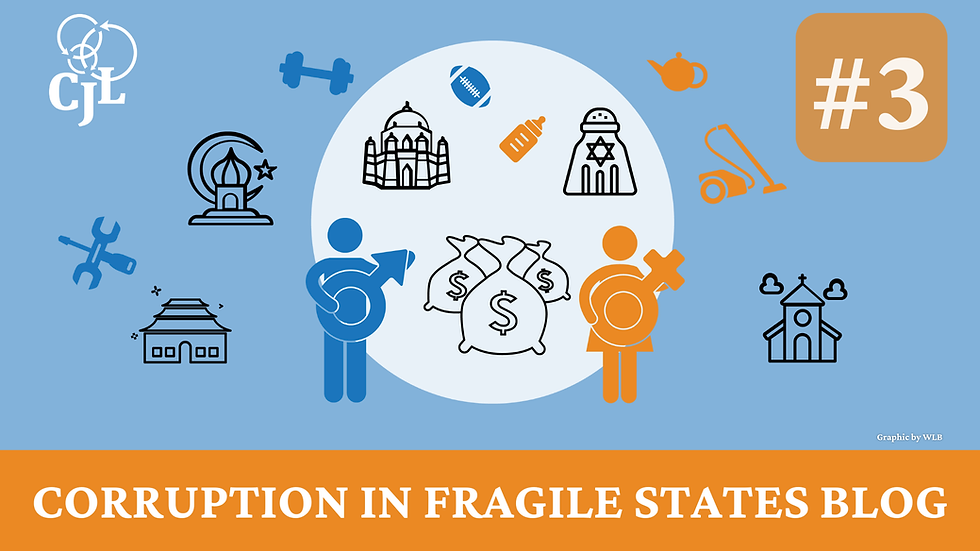What Makes Corruption Complex?
- Cheyanne-Scharbatke Church, CJL

- Jun 22, 2016
- 4 min read
By Cheyanne Scharbatke-Church

Simple and complex contexts are fundamentally different, as was described in last week’s post. The “complexity” or “simplicity” of the situation one is trying to address will affect what kinds of strategies and programs will be effective in promoting change. Yet when a situation is understood—and analyzed—as a simple problem, the risk of adapting a “simple” strategy that cannot address the dynamics of a complex problem is high.
This, we argue, is a challenge in many of today’s anti-corruption strategies being implemented by the international community. Complex systems share certain characteristics that resonate clearly with the reality of corrupt contexts, particularly in fragile contexts:
Lack of agreement on what the problem is
Transparency International’s definition of corruption – the abuse of power for personal gain – dominates the current discourse, but in practice, what constitutes an abuse of power varies in each context, making it impossible to create a universal understanding of what the corruption “problem” is. For instance, in some parts of the DRC providing funds to a police officer so that they can investigate a crime is not seen as a corrupt act by the local citizenry if in exchange the police fulfill their task.
Interconnectedness
Corruption is deeply embedded in social, political and economic dynamics, and cannot be isolated from them because of its many interconnected causes and effects. For instance, a police officer’s demand for a bribe from an ordinary citizen is linked to a chain of expectations and power relations at higher levels of authority. In 2016, for example, the average policeman in Lubumbashi DRC is expected to pay their supervisor 50,000 Congolese francs per month. There are also social expectations from within his/her social groups that drive the need for additional resources. In that situation, corruption cannot be addressed only at the level of the police officer as though it was an isolated transaction between individuals.
Non-linearity and the impact of feedback
With corruption, causes and effects influence each other in a non-linear fashion, which stems from feedback in the system, where “[a] change to any one piece in the system will reverberate [in] or affect other parts.” For instance, citizens may offer a bribe to a court clerk because they believe that the justice system does not function without payment. Yet their perception of the need to bribe is, in part, itself the result of the payments they have made and the number of times such bribes have been seen to have facilitated a transaction with the courts—a classic vicious cycle.
Robust and adaptive
Complex systems are said to be robust (or resilient) because they are able to weather disturbances in the system or environment (e.g. removal of an actor, change of a law) as they adapt in response. We find corruption to be highly resilient and evolutionary. New forms of corruption emerge in response to various anti-corruption efforts, as people, norms, and practices adapt to the new environment. As a result, short-term successes may be unsustainable, or even generate negative effects in the longer run.
Are you using a complex systems lens to analyze corruption? If so we would love to hear more about how you are doing it and the lessons you have learned.
Why are current approaches predominantly simple?
Principal-agent and collective action approaches fail to account for the complex aspects of corruption in several specific ways:
They conflate enablers with causes
While opportunity and incentives are often important enablers, they are not the reasons why corruption occurs; one is not corrupt simply because one has a monopoly, or because of insufficient oversight or accountability. Other forces interact with these enablers to determine whether opportunities for corruption are taken up.
They focus on the individual transaction and not the system
Collective action theories criticize principal-agent explanations for not paying attention to the role of expectations about group behavior in shaping incentives (see here); however, principal-agent and collective action models both take the individual as the main unit of analysis, seeking to understand (and alter) individuals’ incentives to engage in corruption from a cost-benefit analysis perspective. Efforts that focus on the individual corrupt transgression ignore the interconnected nature of corruption, especially as seen in most fragile states. By drawing the boundaries of analysis at the individual (incentives and constraints), the analysis lacks an understanding of the influential way in which multiple drivers of corruption interact to create the corruption dynamic in a specific place.
They are focused on recipes, not on context
The popular corruption risk assessment processes that are used in the anti-corruption world tend to detail where corruption commonly happens in different sectors (labelled as risks) and identify what standardized tools should be used to respond. (For examples see here, here, here or here) These assessments provide universal theory, or “recipes,” that are meant to be replicated across contexts—with variations only in the details of implementation.
Both principal agent and collective active take the model, rather than the context, as the starting point for analysis. The resulting solutions—such as promoting civic engagement, or education and trust-building—are considered universally appropriate to apply in all contexts. Neither approaches question whether the model itself may be inappropriate or insufficient to capture what is happening in the specific context.
About the Author

Cheyanne Scharbatke-Church is Principal at Besa: Catalyzing Strategic Change, a social enterprise committed to catalyzing significant change on strategic issues in places experiencing conflict and structural or overt physical violence. As a Professor of Practice, she teaches and consults on program design, monitoring, evaluation and learning.





Comments